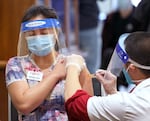Oregon is once again being shorted on the number of COVID-19 vaccine doses it is receiving, state officials said Tuesday. Despite the setback, they announced new details on how the vaccine is being rolled out, including the inclusion of teachers among the essential workers who are being given a high-priority ranking to get vaccinated.
Oregon Health Authority Director Patrick Allen told reporters it will take longer to administer doses to people on the front line because the federal government has cut Oregon’s Pfizer-BioNTech vaccine delivery this week by 15,000 doses, or about 30%. And next week’s Moderna shipments will be 6,000 doses below what Oregon ordered. Allen said the federal government has tended to be overly optimistic about its ability to deliver vaccine doses to the states.
“We all need to understand that our vaccine distribution will be a fluid and changing process as we go forward,” he said.
Allen placed the blame for the changes squarely on the federal government. He said supply chain and shipping issues and other problems could cause Oregon’s number of shipped doses to change.

Dessie Cote, a CNA at Rose Villa in Portland, receives a dose of the Pfizer-BioNTech COVID-19 vaccine on Monday, Dec. 21, 2020 from pharmacist Jordan Tran.
Kristyna Wentz-Graff / OPB
“This does not mean the state did not request enough doses,” Allen said. “We need to be prepared for months of limited supplies, and prioritize who gets the vaccine and when.”
Allen said these unpredictable shortages make vaccine rollout a lot harder. Health care networks and public health officials need to keep a close eye on inventory as they administer vaccines.
Oregon’s vaccine rollout plan prioritizes people into risk-based groups, following recommendations from the CDC. So far, most of the people vaccinated have been health care workers or staff or residents at skilled nursing facilities where a lot of at-risk people live in one place. That’s Phase 1a.
But because of the delays, Allen can’t say how long it will take for Oregon to start vaccinating other people in Phase 1a, like staff and patients in slightly less high-risk group living facilities.
Gov. Kate Brown announced during a video news conference Tuesday that educators will be considered “essential workers” during the vaccine rollout, and be immunized in the next phase of the rollout, which the government is calling “Phase 1b.”
“Getting our teachers and school staff vaccinated will help ensure we are making our learning environments as safe as possible,” Brown said. “We need to make sure our kids know they come first.”
The Pfizer-BioNTech vaccine is approved for people 16 and older and Moderna’s is approved for adults 18 and older.
As well as educators, Phase 1b also will include essential workers whose jobs put them at risk, people over the age of 75 and people with pre-existing conditions. It’s similarly unclear when they could be vaccinated.
“Until we have some kind of a reliable supply that we can predict week in and week out, it is gonna be impossible for us to say, is that gonna be two months from now or six months from now,” Allen said. “I know that doesn’t satisfy anybody, but that is the reality of where these numbers sit right now.”The state hasn’t yet determined how the different groups of people in Phase 1b will be prioritized, or when vaccinations for that group will begin. The CDC has yet to issue any guidance. Rachel Banks, OHA’s director of public health, said the state is assembling a vaccine advisory panel with representatives from different communities, which will help determine how Oregon will allocate its vaccines in Phase 1b.
Tuesday’s news that Oregon will get a lower-than-expected supply of vaccine came after the state was similarly shorted last week by 40%. At the same time, the approval of a second vaccine by Moderna means Oregon will get more doses overall. Allen said Oregon is on track to receive 72,100 doses this week from Moderna, including 12,100 doses that arrived Monday and have already been administered.
He said the Moderna vaccine will be especially helpful in rural areas, where hospitals, nursing homes and other facilities may not have access to ultra-cold-storage freezers, which are necessary to keep the Pfizer-BioNTech vaccine viable.
By the end of the month, Oregon’s supply of vaccine doses from the two drug companies is expected to total 189,722, Allen said.
Brown said Oregonians will play a critical role in making the rollout of vaccines successful by doing their part to keep the virus from spreading while people wait for their turn to get shots. That means wearing face masks in public and avoiding close contact with people from outside their own households. She urged Oregonians to avoid travel and parties during the holidays.
This story will be updated.